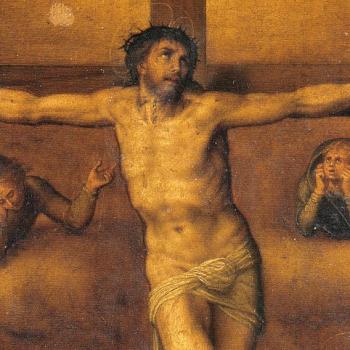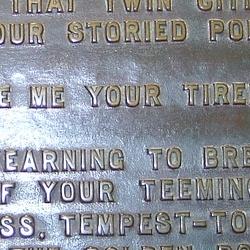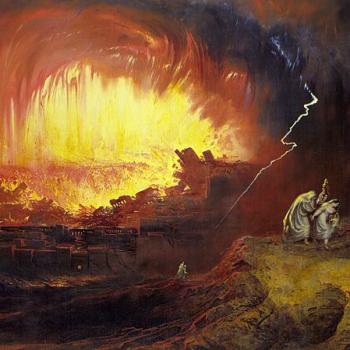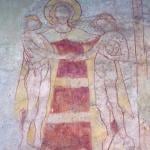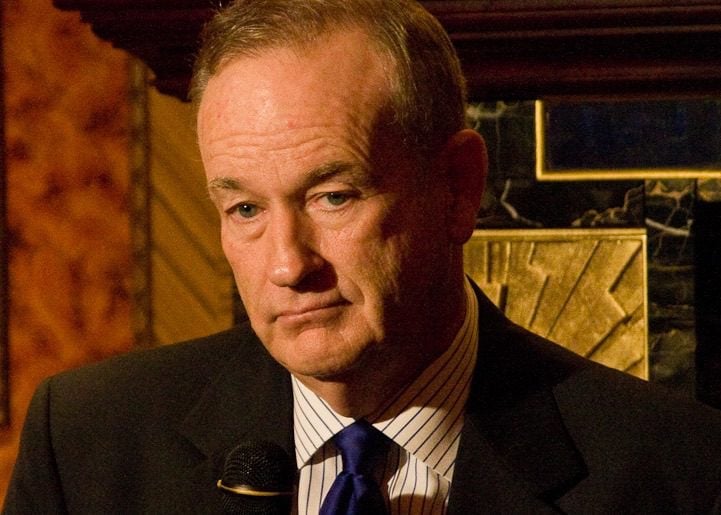
On September 29, Bill O’Reilly was on “60 Minutes” (transcript here) to promote his new book Killing Jesus, written under the inspiration of the Holy Ghost. For when Jesus said that “he will guide you into all truth” (John 16:13), Bill O’Reilly was the very man he had in mind.
I.
The third person of the Trinity speaks to Mr. O’Reilly from afar, but the second person of the Trinity cannot speak to those at the foot of the Cross
By the way, it is interesting to me that, when Pope Benedict XVI published his series of books on Jesus (here, here
, and here
), he took care to point out that he was merely writing as a private theologian and not with infallible authority. For Mr. O’Reilly, however, somehow the third person of the Trinity wakes him up in the middle of the night and says to him, “Write, for these words are true and faithful.” That just strikes me as a contrast worth pointing out.
But digressions aside. During the interview, Norah O’Donnell asked Mr. O’Reilly why he did not record Christ’s “most famous” words from the Cross—“Father, forgive them, for they know not what they do” (Luke 23:34). Here is the exchange that followed:
O’Reilly: We don’t put things in we don’t think happened.
O’Donnell:How do you know?
O’Reilly: Because you couldn’t say something like that, audibly that people would hear. He, you die on a cross from being suffocated. That your lungs can’t take in any more air. You can hardly breathe. We believe Jesus said that, but we don’t believe he said it on the cross, ’cause nobody could’ve heard it.
O’Donnell: But, Bill, you know what people are going to say. “The Bible says that Jesus said on the cross, ‘Father forgive them,’ but Bill O’Reilly says that’s not true, so I should believe Bill?”
O’Reilly: Well you believe what you want. If you want to take the Bible literally, then that’s your right to do that.
[Ah, the condescension! YOU can believe what you want, but WE have done research!]
O’Donnell: But you use as your sources for this book the Gospels of Matthew, Mark, Luke and John. But you pick and choose.
[Indeed. Even Norah O’Donnell can occasionally utter a true statement.]
O’Reilly: Right, but that’s not our only source. I mean, we use Muslim sources, we use Roman sources, we use Jewish sources.
O’Donnell: So is this the Gospel according to Bill?
O’Reilly: This is best available evidence according to Bill. …
Okay, we can stop there. This exchange represents enough confusion on the part of Mr. O’Reilly to handle in one blog article.
Now, several things interest me about the claim that Jesus could not have spoken from the Cross, or that He could not have been heard, due to lack of sufficient air in His lungs.
II.
Inconsistent Spin I: Christ cannot speak from the Cross, but Mr. O’Reilly can quote him
First, in his book, Mr. O’Reilly actually quotes Jesus speaking from the cross. From Killing Jesus:
“I thirst,” Jesus finally says, giving in to the dehydration that has consumed him for more than twelve hours. His voice is not more than a whisper. A solider soaks a sponge in sour wine and reaches up to place it to the Nazarene’s lips, knowing the liquid will sting.
Jesus sucks in the tart fluid. Shortly afterward, he gazes on Jerusalem one last time before the inevitable happens.
“It is finished,” he says. (O’Reilly 250)
Well, which is it? Could he speak or couldn’t he? Perhaps Mr. O’Reilly only means that Jesus could not have spoken as long a sentence as “Father forgive them,” since it would have required more effort than Christ had left in him. After all, he doesn’t quote “My God, my God, why have you forsaken me?” either (Matt. 27:46; Mark 15:34). It might very well be the case that Mr. O’Reilly was merely referring to longish sentences, of more than a few words, but you will search in vain through Killing Jesus to find out. All that he says on the subject is this:
[D]eath on the cross is a slow journey into suffocation. Each time a victim takes a breath he must fight his own body weight and push his torso upward using his legs, thus allowing his lungs to expand. In time, the victim, exhausted, can breathe neither in nor out. (O’Reilly 250)
That’s all.
Now, it is not necessarily a matter of concern that Mr. O’Reilly does not quote Jesus as saying, “Father, forgive them, for they know not what they do.” The Gospel writers themselves did not feel obliged to record every last word Christ spoke, and these words are not found in any gospel but Luke’s. Mr. O’Reilly’s selections are almost identical to St. John’s, with just this one difference: John also records Jesus saying, “Woman behold thy son; [John,] behold thy mother” (John 19:26-27).
But it is a concern that Mr. O’Reilly denies that Christ said “Father forgive them” from the Cross. And so too is the reason he gives for his denial, namely, that crucifixion is “slow … suffocation” and that Christ could not have gotten up sufficient air in his lungs to be heard. To see why, let us look at the relevant text from St. Luke:
And when they were come to the place, which is called Calvary, there they crucified him, and the malefactors, one on the right hand, and the other on the left. Then said Jesus, Father, forgive them; for they know not what they do. And they parted his raiment, and cast lots. (Luke 23:33-34)
Did you catch what I did? I hope so: According to St. Luke, these were Christ’s very first words on the Cross, immediately upon being crucified. In other words, He would have said them before He began to lose air into the lungs—precisely at the time when He had the most ability to speak and the greatest ability to be heard. Asphyxiation, Mr. O’Reilly says, was “slow.” But in order to accept that Jesus could not have said these words, one would have to conclude that, in His case, asphyxiation was immediate. Mr. O’Reilly offers no theory that would explain why Christ alone, of all men ever crucified, suffered immediate asphyxiation; and no one else that I am aware of has proposed any such theory, either.
III.
Inconsistent Spin II: Mr. O’Reilly’s only cited source, a medical doctor, disagrees with him
But that is just one of the difficulties. Second, Mr. O’Reilly cites no source for his claim that crucifixion entails death by suffocation. Not one. The only source he does cite, on the topic of the physiology and forensics of crucifixion, is Dr. Frederick Zugibe’s recent book The Crucifixion of Jesus: A Forensic Inquiry. And Dr. Zugibe has an entire chapter refuting the asphyxiation theory. He says that the theory is
based merely on speculation, a priori reasoning, and repetition. It has not been confirmed by the scientific method until the author investigated it. … [I]t is scientifically untenable … when tested empirically. (Zugibe 101-102)
Dr. Zugibe (who holds both an M.D. and a Ph.D.) goes on to say that the asphyxiation theory was not suggested by anyone until 1925, when A.A. LeBec published an essay in the Catholic Medical Guardian to propose the theory. R.W. Hynek reiterated LeBec in 1936; and finally—most recently, and notably—it was advanced by Dr. Pierre Barbet in 1963. If Mr. O’Reilly had wanted to cite Dr. Barbet, he could have; the work is available—I found it at the library for the local seminary. Here is the relevant passage from the book, entitled A Doctor at Calvary: The Passion of Our Lord Jesus Christ as Described by a Surgeon:
[T]he raised position of the arms, which were in the position for inspiration, would entail a relative immobility of the sides, and would thus greatly hinder breathing out; the crucified would have have the sensation of progressive suffocation.
“Progressive suffocation”: Now, that might be what Mr. O’Reilly had in mind; except that he does not cite Dr. Barbet, and so one can not know. Moreover, this is a dated source; it was published in 1963. It is only that its conclusions, as Dr. Zugibe noted, have found their way into the popular media and have become accepted by force of repetition alone, not necessarily medical evidence and scientific method.
According to Dr. Zugibe (whom Mr. O’Reilly does cite), the theory that a crucified man will suffer asphyxiation was first suggested to Mr. LeBec’s mind through his observation of prisoners of war being hanged from their wrists during World War I. The prisoners experienced difficulty breathing, and had to constantly hunch themselves up and then back down in order to get air into the lungs. But, says Dr. Zugibe, the body position of these prisoners was different than that of crucifixion victims. Their arms were suspended above their heads, rather than extended out at the sides. Moreover, a victim of crucifixion is affixed to the cross also by his feet; whereas, the feet of a hanging victim are left to dangle.
On pages 108-122, Dr. Zugibe describes his own experiments, in which he simulated crucifixion with several volunteers. What he found was that in no case did any of the volunteers have difficulty breathing. They did suffer gradually increasing pain, but they could breathe normally.
IV.
Inconsistent Spin III: Who else besides Mr. O’Reilly makes any such claim?
There is still a third difficulty with Mr. O’Reilly’s hypothesis. I have searched, and I cannot find anyone, who supports the asphyxiation theory, who says that Jesus would not have been able to speak sentences of more than a few words. If Mr. O’Reilly knows of any such source, I would be grateful for the information; for the ones I’ve found go only so far as to say that Jesus would not have been able to say more than three or four words before he had to get another breath. Presumably he could speak longer sentences, albeit in spaced intervals. And even then, that would have been some time late in His time on the Cross; according to St. Luke, Jesus said “Father forgive them” the first moment he was up there.
Thus I am having some difficulty figuring out what the source of Mr. O’Reilly’s information is, and why he accepts it despite the contradiction and evidence from Dr. Zugibe (the only source he actually does cite).
The best that can be said is that “slow suffocation” is a debated and unsettled question even among medical experts. So why is Mr. O’Reilly certain enough on this point that he can deny Christ’s very words from the Cross? Does he have this revelation from the Holy Ghost? And why would the Holy Ghost inspire Mr. O’Reilly to contradict St. Luke? Did the Holy Ghost mislead Luke? Did Luke mishear the Holy Ghost? Has the Church been mistaken about the infallibility of Luke’s gospel for 2000 years? Should Martin Luther have taken that book out of the canon too? And why would the Holy Ghost wait so long to correct all this, and why would he choose a talk show host from Fox News to speak through? Did the Holy Ghost say, “Well, Mr. O’Reilly has earned his reputation for no spin, therefore the folks trust him”? These seem to be questions worth asking.
V.
Inconsistent Spin IV: Christ was suddenly unable to perform miracles?
But let us assume (always a dangerous assumption) that Mr. O’Reilly is right. Just this once. Just for the sake of argument. Just for some fun. So: A crucifixion victim cannot speak from the cross. Let us follow this train of thought and see where it might lead us, based on what we know about Jesus.
Here is what we know:
I. He turned water into wine (John 2:1-11).
II. He raised the dead—not once, not twice, but three times (Mark 5:21-43; Luke 7:11-17; John 11:1-44).
III. He cured the blind—not once, not twice, not three times, but four (Matt. 9:27-31; Matt. 29:30-34; Mark 10:46-52; Luke 18:35-43; John 9:1-12).
IV. He cured lepers (Matt. 8:1-4; Mark 1:40-45; Luke 5:12-16; Luke 17:11-19).
V. He healed the lame (Matt. 9:1-8; Mark 2:1-12; Luke 5:17-26; Luke 13:10-17; John 5:1-18).
VI. He cured a bleeding woman (Matt. 9:18-26; Mark 5:21-43; Luke 8:40-56).
VII. He healed a man with dropsy (Luke 14:1-6).
VIII. He healed a deaf mute (Mark 7:31-37).
IX. He healed the Centurion’s servant (Matt. 8:5-13; Luke 7:1-10).
X. He healed all who touched him in Genessaret (Matt. 13:34-36; Mark 6:53-56).
XI. He performed exorcisms (Matt. 8:28-34; Matt. 17:14-21 Mark 5:1-20; Mark 9:14-29; Mark 16:9 Luke 8:2, 26-39; Luke 9:37-49).
XII. He multiplied loaves and fishes (Luke 5:1-11).
XIII. He walked on water (Matt. 14-22-33; Mark 6:45-52; John 6:16-21)
XIV. He calmed a storm at sea (Matt. 8:23-27; Luke 8:22-25).
But Bill O’Reilly is positive He could not have said “Father forgive them” while He was on the Cross. How is that consistent? Let us have no spin, Mr. O’Reilly: How is that consistent? Do you have a theory as to why Jesus lost his ability to perform miracles while nailed to a tree?
VI.
Inconsistent Spin V: The gospel writers did not understand crucifixion?
We know something else too, which is that the writers of the Gospels, and the audience for whom they were written, were very familiar with the facts of crucifixion—much, much more so than we. They lived with it. They saw it all the time; crucifixion was a public execution. If it was not possible to speak from the Cross, these people were in the best position to have known that. Certainly St. Luke was; he was a doctor. None of the Gospel writers could have made that mistake, and if he had, the audience would have caught it.
So let us assume that a man on a cross could not have spoken. And let us give the Gospel writers credit as people who knew what crucifixion was and didn’t make dumb mistakes. And let us realize, finally, that they are our only eyewitness accounts to Jesus’s life.
What would you conclude?
We know, for example, that when Jesus was on the Cross, He was taunted: If you really are the Messiah, come down, and we will believe you (Matt. 27:41-42).
Well, maybe he didn’t come down. But maybe he spoke. And maybe that was a signal to the chief priests and the scribes and the elders: You have crucified the Messiah. You have crucified God.
And maybe all those verses in the Gospels, recording Christ’s words on the Cross, were also a sign that others might believe: Christ is the Messiah. They would not have needed to be told that it was a miracle. They would have known. They knew what crucifixion was.
VII.
Inconsistent Spin VI: Contemporary eyewitness accounts are less reliable than selective acceptance two millennia later?
But the notion that Jesus did not say “Father forgive them” actually originated with the Jesus Seminar, a group of cranks masquerading as scholars who get together and vote with colored beads what Jesus “really” said and what he didn’t say. Their methodology is a tad lacking, to put it gently. It is not my purpose here to go into analytical detail about the Jesus Seminar—that can be saved for another time. But I do think it is worth pointing out that Mr. O’Reilly has allowed himself to be swayed by the—ahem—spin of a group that has more talent for getting popular attention than it does for scholarship.
There is a popular myth—popular since the nineteenth century—that it is important to search for the “historical Jesus,” who is somehow to be differentiated from the Jesus of the Gospels. And while I do not want to minimize the importance of historical or scientific research (far from it), it must be pointed out that this effort is as fraught with peril as the effort to divorce the laws of science from the One who created them in the first place.
Jesus was not just an historical figure; He was God. The only eyewitness accounts we have of His life were written by believers with the purpose of turning other men into believers. You cannot separate Christ from faith; as C.S. Lewis rightly pointed out, He did not leave that option open to us.
When you attempt to separate the “historical” Jesus from who He was and the purpose for which He came, you end up—inevitably—denying large amounts of what He said and what He did. You end up picking and choosing—as Norah O’Donnell pointed out—what you want to accept and what you do not.
What you pretend to be your reason ends up killing what there may have been of your faith.
In the case of Mr. O’Reilly, however, even his “reason” and his “history” end up falling short of standards of logic, consistency, and medical evidence.
WORKS CITED
***
If you like the content on this blog, your generous gift to the author helps to keep it active. I remember all my supporters in my Mass intentions each week.




